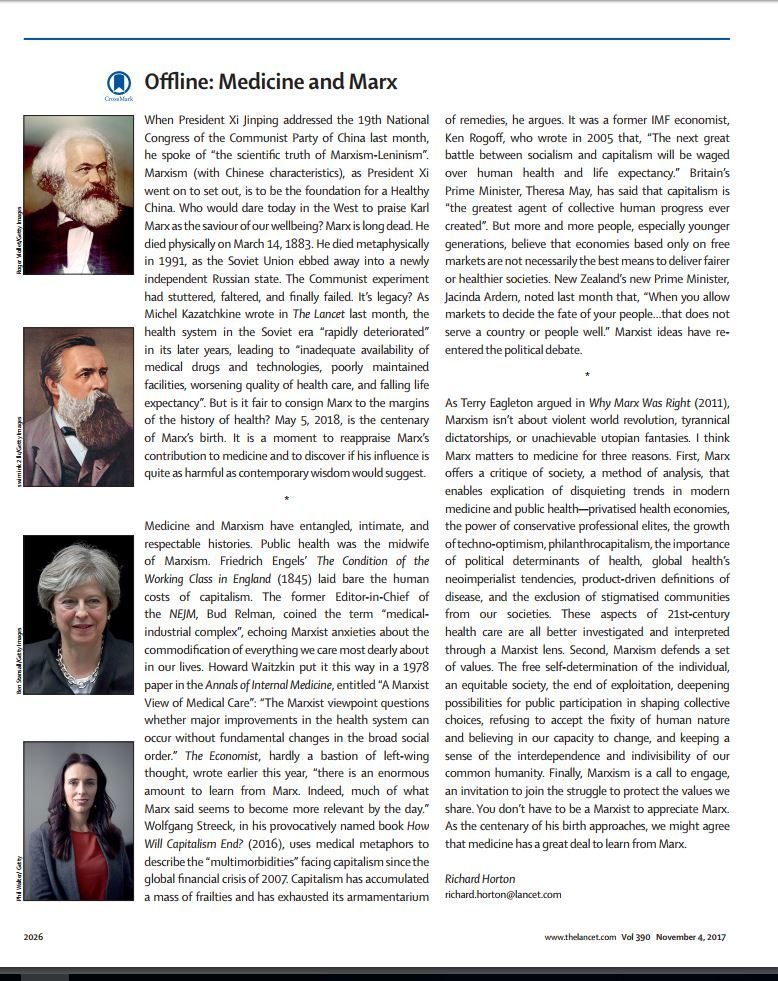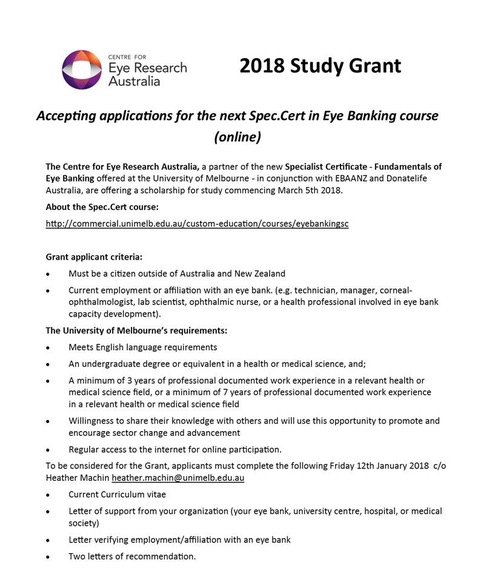Neo-Marxists intend to turn capitalism into a disease
Red meds
Neo-Marxists intend to turn capitalism into a disease
In November’s Lancet, editor Dr Richard Horton has liberated his esteemed medical journal from the shackles of science by inviting us to resurrect Karl Marx as the saviour of medicine. His paean to Marx is a confusing blancmange of naïve romanticism and sophomoric cliché. Marxism, he pleads un-ironically, offers a ‘critique of society’, a ‘method of analysis’, a ‘call to engage’, and more than a legacy of famine, genocide and failed states.
This is not satire. Like many physicians in positions of influence, Horton still believes that capitalism is the stubborn obstacle to fairer and healthier societies, and that, (quoting Howard Waitzkin) ‘fundamental changes in the broad social order’ are necessary. Whilst he notes that many young people are sceptical of the influence of free markets on society, he ignores the fact that a majority of these critics live at home on parental largesse. Thanks to a feelings-based educational system born of the Frankfurt School, youngsters of Western democracies have little knowledge of the murderer’s row of socialists who successfully ‘changed the social order’. Pol Pot, Mao and Lenin are names largely absent from contemporary history curricula. Horton chooses NZ’s very green PM Jacinda Ardern to paraphrase in support of his thesis. That the millennial Ms Ardern should be considered a ‘go-to’ authority on such matters should trouble Kiwis and Marxists alike.

Socialists make the category error of viewing capitalism as a system; an evil inversion of their own utopian ideal. Capitalism is simply the emergent result of individuals freely exchanging goods. It is neither inherently virtuous nor wicked. It makes no grandiose claims about perfecting society. Horton ignores the necessary contributions of the free market to healthcare. Everything from surgical masks to antibiotics, IT systems, and even Apple Macs used by Lancet editors is the happy result of profiteering. Competition insures that these goods are affordable and high quality. Whilst capitalism permits competition for production, Socialism promotes competition for consumption. If Horton wants less Big Pharma, the solution isn’t more government; it’s to allow lots of little Pharmas to flourish. The UK’s National Health Service is both an exemplar of the failures of socialised medicine and one of the greatest marketing successes in history. Britain’s relationship with the NHS has something of the Stockholm syndrome about it. Britons defend their health service in the same tones as a wife making excuses for an abusive spouse. A structural flaw of limited supply and infinite demand condemns the NHS to perpetually inadequate resourcing. Despite its mediocrity, the NHS does experience considerable health tourism, but patients are more likely to be from Nigeria than from, say Switzerland. That there can never be enough money is a feature, not a bug. For the evangelical socialist there is no limiting principle, and hence there is always a justification for revolution.Meanwhile, individual patients passively endure queues, hospital-acquired infections, poor cancer outcomes and lack of physician choice. Incidentally, the greatest barriers to satisfactory healthcare in the developing (Marxist) world include cronyism, lack of political and trade freedoms, aid diversion and corruption. Rather than focussing on those, Horton frets about ‘techno-optimism’, ‘philanthrocapitalism’, ‘multimorbidities’, ‘neoimperialism’, and other scary portmanteaux.
Horton’s boast that Marxists refuse to accept the fixity of human nature is also absurd; Marxists eschew the very existence of human nature in favour of the idea of the tabula rasa. The dogma that health is socially determined stems from this fallacy. For the socialist, inequality is considered the Holy Grail of health determinants. Readers may remember activist researchers Richard Wilkinson and Kate Pickett. Their 2009 book The Spirit Level caused a stir, purporting to show that the steeper the social gradient within a society, the more likely all citizens experience poor health outcomes. They argue it isn’t absolute poverty, but the gap between rich and poor that matters most. Sadly for the true believers, this field of research is prone to cause and effect substitution, cherry-picking of data, and the minimising of cultural factors.
Unsurprisingly the biological mechanisms mediating the supposed Spirit Level phenomenon remain elusive. One fashionable idea is that harmful hormones and inflammatory cells attack our bodies if we are exposed to very specific micro-traumas. Examples might include the stress of being an employee rather than a boss, or discovering that your neighbour has a newer Lexus than you (a condition previously known as envy). So not only is capitalism exploitative, but unhealthy too. A big dose of taxation will cure this ill.
Horton’s assertion that public health is the ‘midwife’ of Marxism depends on how public health is defined. If he means what Richard Epstein terms the ‘old’ public health i.e the development of epidemiology, sanitation and vaccination, then he is drawing a long bow. Advances in longevity, reductions in infant mortality and the treatment of communicable diseases began with scientific explosion of the Enlightenment and emerged as one of the fruits of Western Civilisation. It was the spirit of Victorianism that gave us the public health innovations of Snow, Bazalgette and Chadwick. But Horton’s version of ‘public health’ is more ominously totalitarian. His airily vague aspiration for ‘public participation in shaping collective choices’ means in reality an ever-expanding list of paternalistic impositions aimed to protecting people from themselves without their consent.
Christopher Snowdon’s recent book Killjoys: A Critique of Paternalism surgically dissects many of these illiberal preoccupations; from the banning of alcohol to the mandatory restriction of restaurant portion sizes. In this world, the cost of a theoretically marginal rise in life expectancy at a population level is offset by forbidding everything save for cycling and literary criticism. In a free society, consequences of bad choices are borne primarily by the individual. Socialism achieves a double whammy; simultaneously encouraging the intemperate to disavow personal responsibility whilst forcing the prudent to underwrite the cost. Let’s please consign Marx to the annals of history.
READ MOREMedicine and Marx
Medicine and Marx

Why spending time outdoors could help your child’s eyesight
Why spending time outdoors could help your child’s eyesight
By Katherine Sellgren
BBC News

Kids seem to spend endless hours on smartphones, games consoles, computers and tablets these days.
Playing on electronic devices certainly doesn’t help their waistlines, but do you ever wonder what regular device use is doing to their eyesight?
While there isn’t much research out there yet about the impact of screens on eyesight – after all the iPhone was first unveiled by Apple in only 2007 – experts are concerned about growing levels of short-sightedness in children.
And they suggest the best thing parents can do to prevent it is to encourage youngsters to spend more time outdoors in the sunlight.
How short-sightedness is on the rise
There has been a massive rise around the globe in short-sightedness – or myopia as it’s officially known – over recent decades.
“We know that myopia or short-sightedness is becoming more common,” says Chris Hammond, professor of ophthalmology at King’s College London and consultant ophthalmic surgeon at St Thomas’ Hospital.
“It has reached epidemic levels in East Asia, Singapore, Taiwan, South Korea, where approaching 90% of 18-year-olds are now short-sighted.
“In Europe, it’s potentially getting up to 40% to 50% of young adults in their mid-20s who are short-sighted now in Western Europe. It’s been gradually rising over the decades of the 20th Century from around 20-30%.”
Why has it become so much more common?
Annegret Dahlmann-Noor, consultant ophthalmologist at Moorfields Eye Hospital in London says lack of natural light seems to be the key issue.
“The main factor seems to be a lack of exposure to direct sunlight, because children who study a lot and who use computers or smartphones or tablet computers a lot have less opportunity to run around outside and are less exposed to sunshine and because of that seem to be at more risk of developing short-sightedness.”
Prof Hammond says: “It may be that there’s no coincidence that in East Asian countries, the most myopic ones all correlate with the maths league tables.
 “These kids are being pushed with very intensive education from a very young age and spend a lot of time indoors studying everything close up and very little time outdoors.
“These kids are being pushed with very intensive education from a very young age and spend a lot of time indoors studying everything close up and very little time outdoors.
“Therefore the concern is that all close work – like playing with the iPad and iPhone – carries the potential that it could make them more short-sighted.”
So should we stop or limit screen use?
Well that’s much easier said than done! Any parent will know that youngsters are like dogs with bones when it comes to their beloved phones and trying to get them off their devices is pretty much impossible – certainly without a massive argument.
Dr Dahlmann-Noor, who is a mother of three, says trying to stop screen use is probably an unrealistic aspiration.
“You can only tell them that it might make their eyes uncomfortable, it might make them short-sighted and they should not use it as much as they like to.
“But, hand on heart, I don’t think we can get away from this because they also have to do their school homework on laptops and iPads and they do their searches for background information on screens.
“If you’re a teenager and you have got revision to do for GCSEs or A-levels then you can’t really switch off, can you? So I don’t think we will be reducing the screen use, really, in years to come.”
Time outdoors is the key
The best thing to do, say the experts, is to get children playing outside as much as possible.
“Protective of myopia development is time outdoors – sport and leisure outdoors are protective of eyesight,” says Prof Hammond.
“In a perfect world, probably on average across the week and the weekend, two hours a day outdoors is protective of becoming short-sighted in children.”
- Game used to test children’s eyesight
- What is the food that can really improve your eyesight?
He says myopia research done in Sydney, Australia showed that only 3% of Chinese-heritage children living in Sydney – who spent two hours a day outdoors – were short-sighted by the age of six, compared to nearly 30% of six-year-olds in Singapore.
“So again, suggestive that the outdoor lifestyle is good for our eyes.”
And don’t forget your veg
Dr Dahlmann-Noor says diet is also an area where families can help with eyesight.
“We always tell parents about omega-3 essential fatty acids, and vitamins A, C and E and nutrients that are good for the back of the eye.
“Healthy diet really is important – in terms of getting oily fish, avocados, green vegetables, green leafy vegetables as much as possible.

“Or in children, all these supplements that you can buy over the counter that are good for the brain, also happen to be good for the eyes – they’re just not marketed for that.”
She also recommends regular annual eye checks.
How would I know if my child was becoming short-sighted?
According to NHS Choices, signs that your child may be short-sighted include:
- needing to sit near the front of the class at school because they find it difficult to read the whiteboard
- sitting close to the television
- complaining of headaches or tired eyes
- regularly rubbing their eyes
When someone’s short-sighted, the eyes have grown slightly too long, which means light rays focus just in front of the retina, at the back of the eye, so distant objects to appear blurred, but close objects are seen clearly.
Hope for tomorrow’s treatment
While levels of myopia are likely to continue to rise, the hope is that researchers will find ways to reduce its progression.
Dr Dahlmann-Noor says: “What we need to look at, in terms of research and development, is ways of modifying the impact that these activities have on their visual development.”
Prof Hammond adds: “There are eye drops and other treatments to slow myopia progression. But in terms of preventing myopia itself, there isn’t any data out there at the moment in terms of ‘Could the drops we use to slow progression stop myopia developing at all?’
“I think it’s going to be the logical next step of research studies, as in countries like urban China – where 10% of children in each class per year are becoming short-sighted from about the age of six – there’s an argument for saying we should be trying to prevent it.”
READ MORE
Study Grant 2018
A Specialist Certificate in the Fundamentals of Eye Banking will equip graduates to work within the specialist field of eye banking. The course has been designed to support existing eye bankers, those new to the sector and those working in peer and relevant sectors who wish to gain additional knowledge about eye banking in order to support their own area of specialisation.
Course details: http://commercial.unimelb.edu.au/custom-education/courses/eyebankingsc
READ MORECall for Courses – AAO 2018 Chicago
The American Academy of Ophthalmology (AAO)’s 2018 Annual Meeting, that takes placesOctober 27-30 in Chicago, Illinois, is being organized in conjunction with the Pan-American Association of Ophthalmology (PAAO). The AAO has invited PAAO to participate in the scientific program. We would like to encourage participation from our colleagues from the Americas, Spain and Portugal.
The Academy will accept abstract proposals for courses and skills transfer labs starting December 14, 2017 through January 9, 2018, and this deadline is strictly enforced. The abstract submitter automatically closes at midnight, 12 am PST (San Francisco time). Please find the link to submit your course: https://www.aao.org/annual-mee
Please note that acceptance into the scientific program is not automatic. The AAO has a Review Committee and each submission is reviewed and graded from 1 to 5 points. All accepted submissions must have a grading of 3 points or above.
The two requirements are:
- all presentations must be in English and
- at least one of the speakers in each course must be an active member of the AAO.
Please see the link for specific instructions for submitting a course:https://www.aao.org/annual-mee
We strongly encourage our colleagues from the Americas to participate in more international Congresses and this is an excellent opportunity. We welcome you to submit a course abstract for consideration.
If you have any questions, please do not hesitate to contact me atfernando.arevalo@paao.org.
Best regards,
J. Fernando Arevalo, MD FACS
President of the Pan-American Association of Ophthalmology
Academia Ophthalmologica Internationalis Member (Chair: XXIX)
Edmund F. and Virginia B. Ball Professor of Ophthalmology
Chairman, Department of Ophthalmology
Johns Hopkins Bayview Medical Center
Retina Division, Wilmer Eye Institute
The Johns Hopkins University School of Medicine
Baltimore, MD, USA
Phone: 443-287-9554 (Johns Hopkins Hospital)
E-mail: arevalojf@jhmi.edu
E-mail: arevalojf2020@gmail.com
Twitter: @ArevaloJF
World Sight Day 12th October 2017 Barbados Advocate
 Make Vision Count
Make Vision Count
The Ophthalmological Society of the West Indies (OSWI) joins the rest of the world today in commemorating world sight day (WSD), an international day of awareness, held annually on the
second Thursday in October, to focus attention ok the global issue of avoidable blindness and visual impairment.

